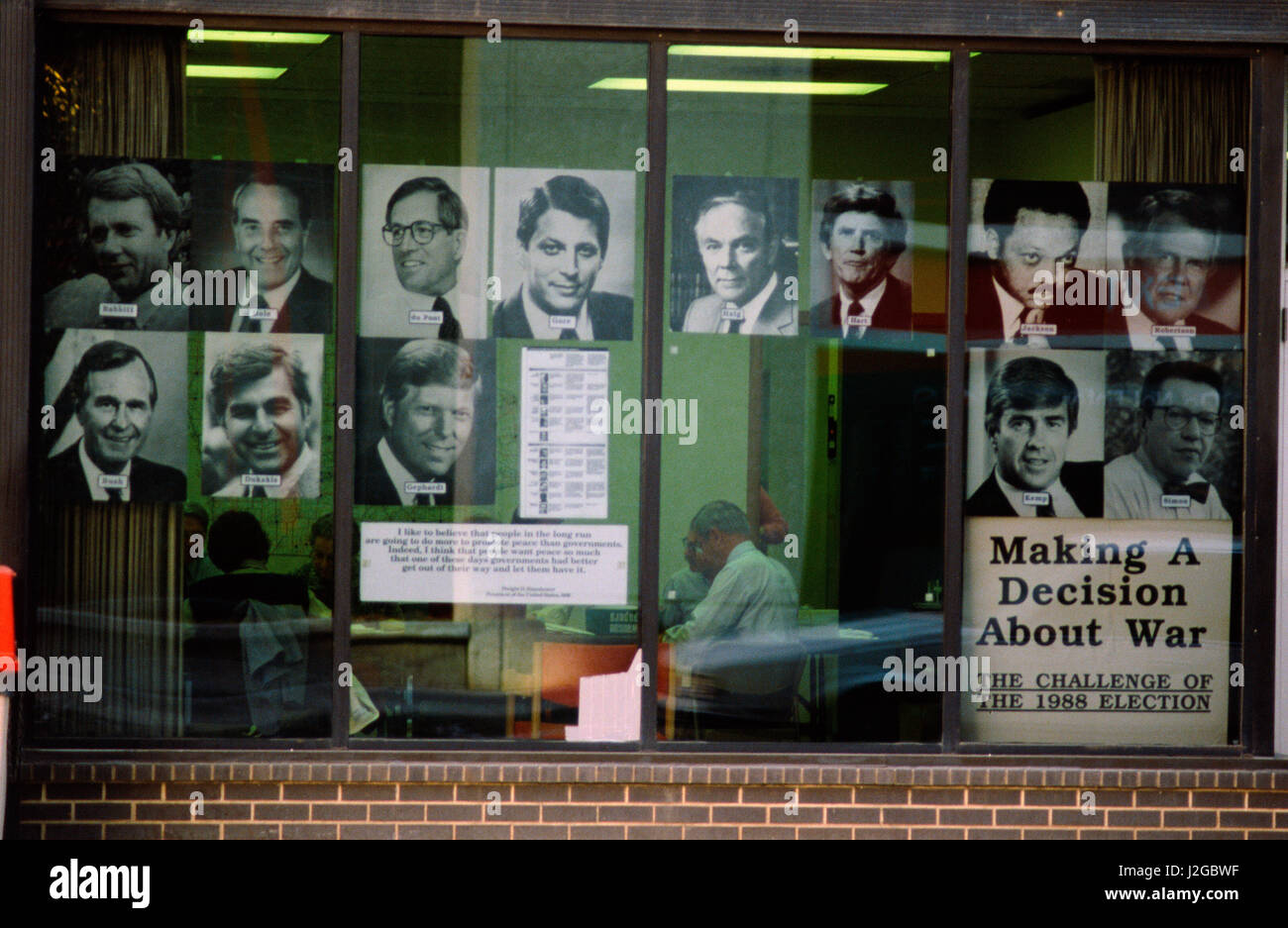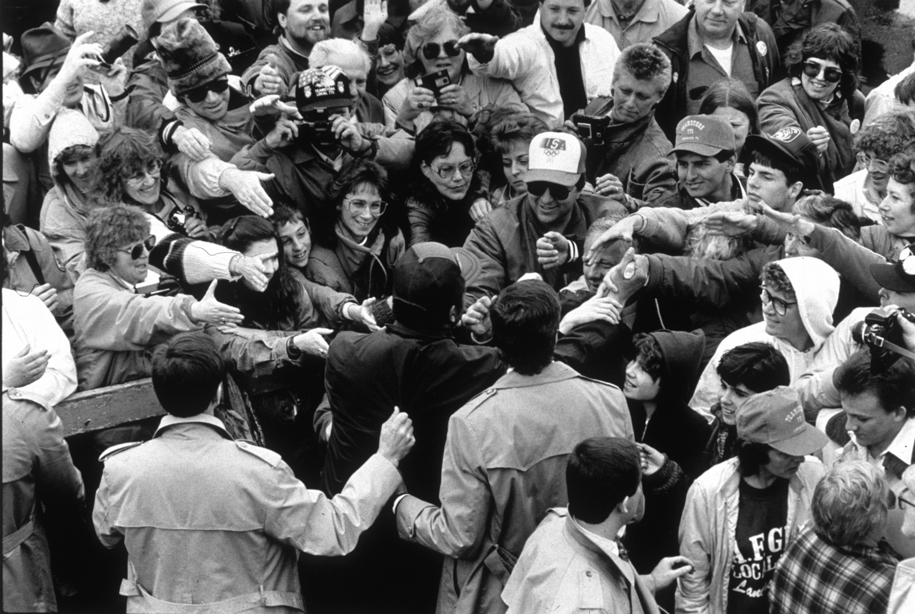In the Heartland
Another day, another speech. That had been the Mark Green’s life for the last year. Normally he wouldn’t complain: After all, being the chief speechwriter for the Democratic frontrunner for President was a pretty big gig. But as November turned to December, and the Iowa weather turned from “cold” to “so g-damn cold your breath froze and dropped to the ground,” the job didn’t feel all that special. Trying to write on the back of a campaign bus cruising down frequently bumpy old roads wasn’t easy either. But Mark Green was here, and if he was here, he was going to do the best damn job that he could. The same could be said for the rest of the political team. Joining Green on the ground were many of the campaign’s top staffers: Billy Shore, Joe Trippi, and John Emerson. Of course, there was the candidate too, although it sometimes didn’t feel that way.
Gary Hart’s year had been an exciting one. Jumping into the race with sky-high poll numbers, he spent the spring and summer of ’87 campaigning nationally on a positive message of “Leadership with Courage.” His future-focused platform talked about such ranging topics as military reform, making workers more competitive globally, and a new grand foreign policy for the post-Cold War world. Hart’s ease of addressing big issues and front-runner status made him a much-sought after guest on the Sunday talk shows and weekly magazines. Things were purring along nicely: Money was flowing in from all the right places, and pretty soon his debt from the 1984 campaign was cleared out. His speeches were well-attended, and endorsements were coming in fast. But underneath this strong façade were a number of weaknesses.
At the end of the day, most voters still didn’t feel like they “knew” Gary Hart. This was the same old complaint that dogged him four years earlier. Focus group after focus group said that while they really liked what he was saying, they saw Hart as “aloof”, “too academic,” and “not really genuine.” This was, in short, a problem. Coming off of the Reagan years, in which most Americans saw a President who oozed likeability, Hart’s demeanor appeared cold and strange. There was also the issue of his actual record. Despite running as a new kind of Democrat, Hart’s record in the Senate placed him on the left wing of his caucus. Sure, he introduced plenty of interesting bills (that got nowhere), but when the roll was called, Hart found himself with the likes of Ted Kennedy more often than his rival for the nomination, Al Gore. Normally this wouldn’t be an issue: Democratic primary voters were more liberal than the nation as a whole. But after the landslide defeat of Walter Mondale, as well as one sixteen years earlier in 1972 with George McGovern (led by campaign manager Gary Hart), Democrats were looking for a more moderate nominee. At least that was the logic of nearly half-a-dozen of the candidates for the nomination.
While the national polls showed Hart far ahead of the competition, the Democratic primaries were not a national election. Rather, they were a slew of “clumped” state elections. That was especially the case in 1988. Concerned that the party was moving too far to the left, many moderate and conservative Southern politicians moved their primaries to one day: March 8th. Known to the media as “Super Tuesday,” the plan was to create a firewall which would block any left-wing candidate from securing the nomination. Two Southerners jumped into the race with the goal of knocking the other out before that crucial day, and then racking up delegates-a-plenty in their native region. The first of those candidates was Tennessee Senator Al Gore. The son of a Senator, Gore had a moderate record in Washington. He was seen as tough on defense and crime, with some fiscally and socially moderate votes thrown in. But he was also a liberal on the environment, and much like Hart, was running as a candidate for the future. But what he had in new ideas, he lacked in charisma or name recognition. The former was not a problem for the other Southerner in the race: Arkansas Governor Bill Clinton. A classically gregarious Dixie poll, Clinton’s message of investing in public education and reforming welfare played right into the moderate Democratic Leadership Council’s (of which he was a founding member) playbook for winning in the ‘80s and ‘90s. He had a bright and sunny disposition that hid the fact that he was as intellectual as any candidate for the office. Clinton didn’t have much money, and was no better known than Gore outside of his home state, but he hoped to make up for it with strong debate performances and good old-fashioned retail politics. He too was young: 42, to Gore’s 40.
Ironically one of the politicians responsible for creating Super Tuesday, Florida House Speaker Jon Mills, was a co-chairman of Hart’s campaign. Mills, in an interview with CBS, still eschewed confidence that the Southern states would support his man: “We’re going to come out of Iowa and New Hampshire with the momentum behind our back, and you can count on the good people of Florida and all across the South supporting Gary.” Of course, that put an awful lot of pressure on the good people of Iowa and New Hampshire. Several candidates were planning on stealing Hart’s momentum in those states. In Iowa, it was the two Midwesterners: Representative Dick Gephardt and Senator Paul Simon. Gephardt, the Chair of the House Democratic Caucus, had begun his career as a moderate with a record akin to Gore’s or Clinton’s. But as he rose in the House, he began to shift his focus towards one issue in particular: foreign trade, and with it, deindustrialization. Representing St. Louis in the House, Gephardt had seen the results of shuttered factories first hand, and he took the lead in trying to halt the expansion of liberalized trade relations with developing countries. This stood in stark contrast to Hart’s focus on helping American workers by investing in greater education, training, and research and development. But it was a message that played well in a state like Iowa, who’s small towns were in a world of hurt. Senator Simon, from Illinois, took a different path. He was a wonk, much like Hart, but came from the old school New Deal style of politics. He ran on massive investments in health care, infrastructure, and education, while somehow also supporting a balanced budget amendment to the Constitution. Simon’s appeal was as much his unique personality and sense of style as it was due to his policies. Wearing a pair of Coca-Cola frame glasses and sporting an eccentric bow-tie, Simon looked like someone right out of a Norman Rockwell painting. He stood in clear contrast to the more polished and traditional looking politicians frequently flanking him on the debate stage.
Joining Gary Hart in the “neoliberal” camp (a term no one could quite define, but was all the rage) were a pair of Governors from opposite ends of the country. Bruce Babbitt, of Arizona, was the quintessential 1980s Democrat. Succeeding to the Governor’s office in 1978, Babbitt developed a reputation for two causes: fiscal responsibility and environmentalism. This seemingly odd pairing played very well with the Washington press corps, who praised him for “speaking hard truths.” But those truths weren’t poll tested and played poorly with the people who actually decide who becomes President: the voters. Support a national sales tax, for instance, didn’t sit well with Americans already struggling to pay the bills. A stronger candidate hailed from the Northeast: Michael Dukakis. As Governor of Massachusetts, Dukakis (or “The Duke” as he was jokingly referred to) came from a family of immigrants and worked his way up to the top office in the State. After an ill-fated first term, Dukakis came back to preside over the so-called “Massachusetts Miracle” in the ‘80s. This period of dramatic economic growth was driven by an early tech boom, and Dukakis’ wise economic stewardship and focus on investments in education proved key. In his run for President, Dukakis focused on the future, much like Hart, but also his own personal background and experience as an executive; two traits that contrasted positively with Hart’s weaknesses. For Dukakis, New Hampshire was the key. If he could win there, his seasoned campaign team figured, they could square-off with Hart one-on-one and win in the contest of experience and personality.
The final figure in the contest for the Democratic nomination was arguably the most polarizing, and the most dynamic. Four years earlier, Reverend Jesse Jackson had skyrocketed from after-thought to serious contender with a series of surprisingly strong performances. In state after state, Jackson finished in the same pack as Hart and Walter Mondale. His message that year was far to the left, and aimed primarily at African-American voters. But this time, Jackson was gunning for the nomination itself, and that meant expanding his coalition. Instead of running a campaign based on race, the Civil Rights-era protégé of Dr. Martin Luther King, Jr. focused heavily on economic issues and inequality. He focused heavily on fighting poverty, a federal jobs program, and opposing corporate greed. This message was aimed as much at white working-class voters as it was at lower income African-American and Latino communities. It also struck a cord with a large number of liberal whites, who were frustrated by their party’s perceived shift to the right, at least on economic issues. Unlike most other candidates, Jackson’s strategy was not to do well in rural Iowa and New Hampshire, states with a very low number of minority voters, but instead to beat the DLC at their own game by sweeping the South and rolling up big wins in the Rust Belt. Leadership within the party was terrified that Jackson would actually win, and potentially guarantee a third straight Republican landslide. This helped one candidate in particular: Gary Hart.
And so, as the leaves fell from the trees and the first snowfall of the year spackled the Iowa farmland, Mark Green and the boys on the bus trudged onward in the quest for the nomination. National polls showed Hart holding a steady lead over Jackson and the rest of the pack, with the polls in Iowa showing a slightly different story. Hart was locked in a three-way tie with Gephardt and Simon, with his strongest numbers in the state’s college towns, while Gephardt and Simon largely split the rural and working-class communities. That was why Green and company were traveling to yet another farm town with the candidate; their aloof and distant intellectual who promised to turn America around, especially for these very working communities who were struggling so much. Sometimes Green wondered why he didn’t just hang up his cleats and work a real job, maybe at an NGO or public interest law firm or something. But as they pulled into the Le Claire high school parking lot, Green glanced towards the back of the bus. Gary Hart got up from his seat and looked forward towards his speech writer. He shot him a wink, a smile, and joked “Ready to go Greeny?” He was.
:no_upscale()/cdn.vox-cdn.com/uploads/chorus_asset/file/13393437/GettyImages_161992083.jpg)
:no_upscale()/cdn.vox-cdn.com/uploads/chorus_asset/file/13393437/GettyImages_161992083.jpg)






